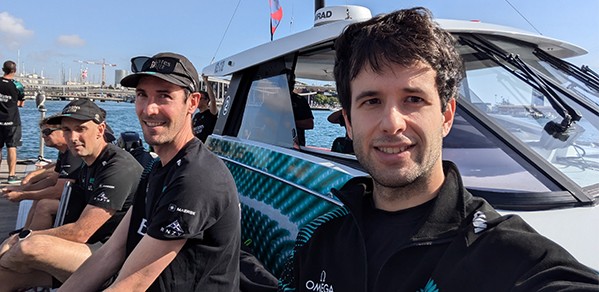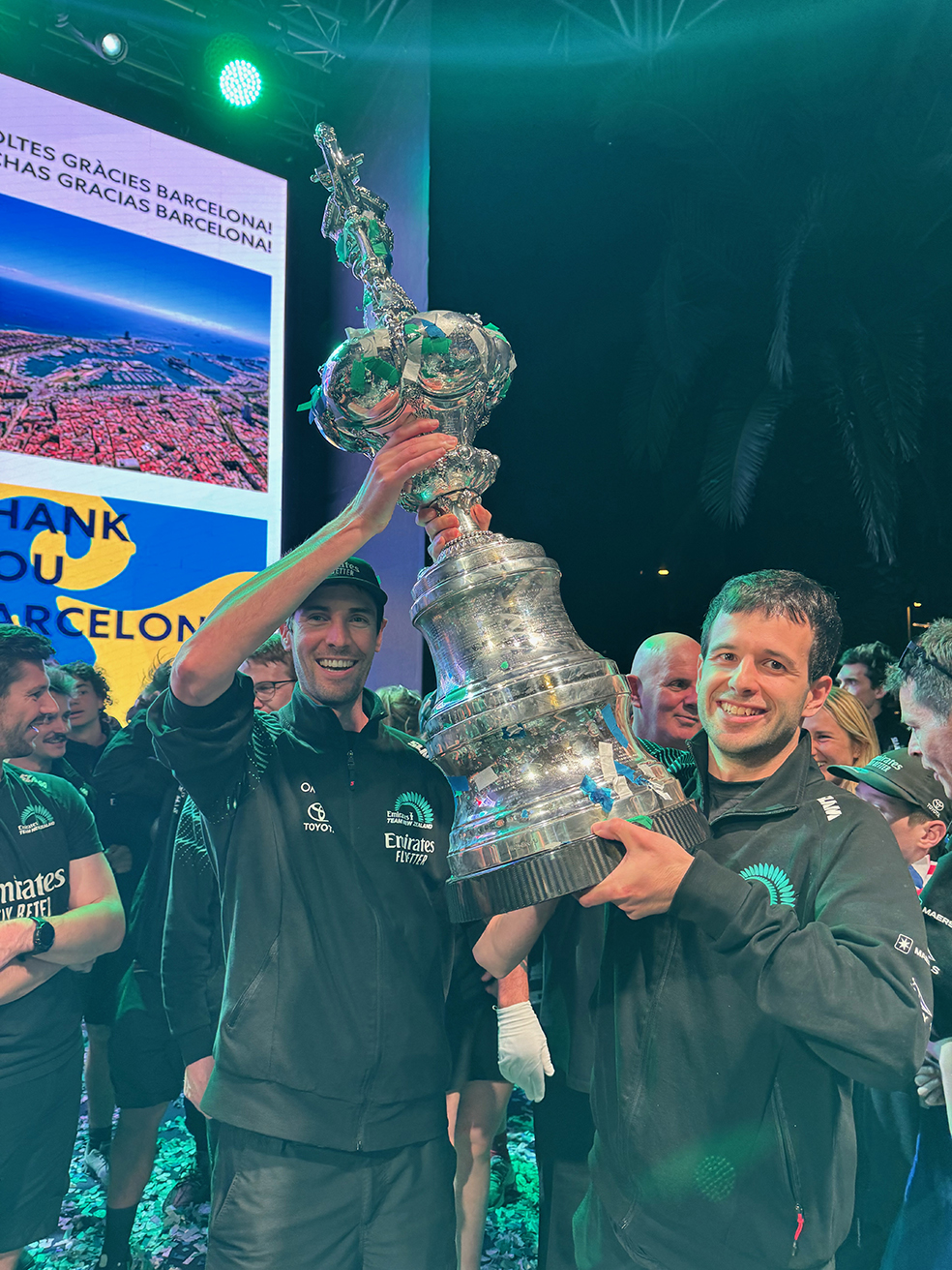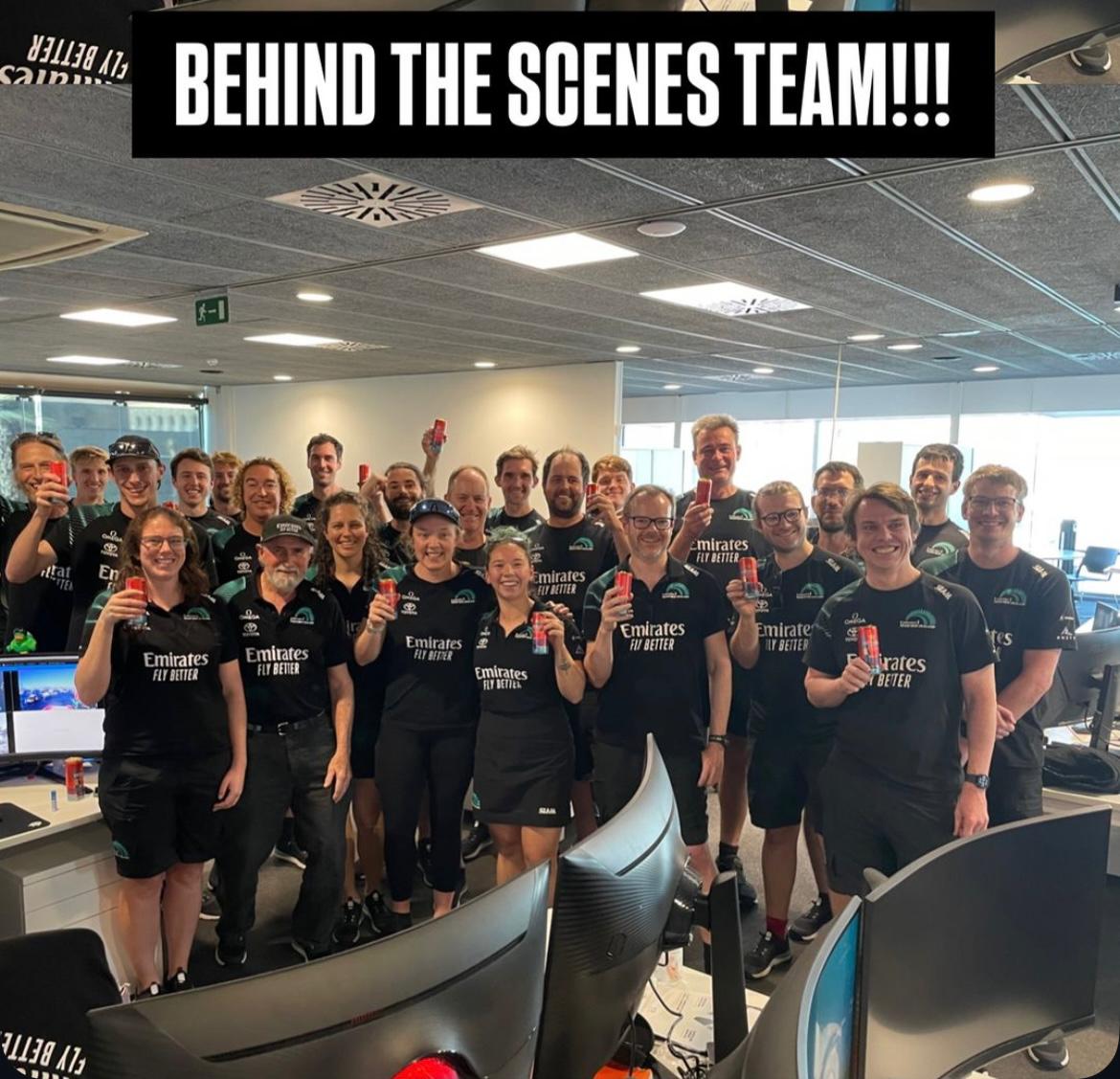
Yacht racing is a rewarding yet gruelling challenge, but what does it take to win? Alumni Simon Corkery and Ignacio Andreu Angulo were part of the design team behind the ‘fastest yacht’ that won the 37th America’s Cup recently – yachting’s most coveted prize.
Winning the Cup was an unforgettable experience – a sense of accomplishment that I will always remember. The fact that we are competing against other teams of equally talented engineers, made the journey even more rewarding.
Alumnus Ignacio Andreu Angulo
Here they talk us through the role engineering played in the success of the AC75 class – a yacht that’s designed to fly.
They also share their experiences as part of Emirates Team New Zealand (ETNZ), and details about their time spent studying for PhDs at Cambridge in the Department’s Energy, Fluids and Turbomachinery division.
Simon: The America’s Cup is an event held approximately every three to four years and showcases the world’s top sailors in the most technologically sophisticated race yachts.
The event is extremely prestigious and competitive, with each team investing around £100 million in the hope of winning the trophy. Over the course of a campaign, the teams must design, build, learn to sail, and compete in a yacht, where its basic specification has been defined by the current defender and challenger of record.
The latest iteration of yacht, the AC75 class, is a 75-foot foiling monohull capable of reaching speeds of up to 55 knots (63mph), where the water around the hydrofoils boils because of the surrounding pressures. The hull lifts out of the water on hydrofoils – or ‘flies’ – when the wind gets above a certain speed.
These yachts are designed to be as aero- and hydrodynamically efficient as possible, which comes at a cost, namely that of stability and the yacht's ability to sail, thus rewarding the sailors who can sail accurately in ever-changing conditions.
Fluid mechanics for yacht design
Simon: The primary aim of the yacht design team is to deliver a racing yacht to the sailors that gives them a competitive edge. What is the most effective advantage you can have, you ask? Well, that is a yacht that can sail upwind and accelerate out of manoeuvres faster than the opposing yacht. This in turn allows the sailing team to tactically control each race.
A strong understanding of fluid mechanics is critical in achieving such an advantage. There are only three ways to increase the boat speed:
- The first involves improving the aerodynamic thrust on the yacht provided by the hull and sails.
- The second is by reducing the hydrodynamic drag on the hydrofoils.
- The third is by understanding the environment in which the boat is extracting its energy from (e.g. wind, wave and tidal fields) to ensure that the aerodynamic surfaces are optimised for the race conditions.
Fluid mechanics is at the heart of each of these areas. We spend a lot of our design time developing the aerodynamic and hydrodynamic models employed in the design of the boat, whether that be low fidelity models or all the way up to complex computational fluid dynamics (CFD) simulations of the entire yacht.
One of the real challenges that we face is determining whether we can sufficiently trust that our models are a good representation of the real-world physics, so where possible, we will also embark on experimental campaigns to validate either some of the physics, or the performance of the yacht as a whole.

Lifting the America’s Cup and being a team player
Ignacio: Winning the Cup was an unforgettable experience – a sense of accomplishment that I will always remember. The fact that our work is part of a high-stakes competition, where we are competing against other teams of equally talented engineers, made the journey even more rewarding.
Simon: The great part of working within the design team at ETNZ is the collaboration opportunities with a group of truly world-leading engineers in their respective areas, as well as the sailing team who are ultimately the end customers.
The design team at ETNZ is only around 35 persons in its entirety. This group is responsible for the aero- and hydrodynamics, optimisation, structural design, software and control, hydraulics, electronics, mechanical design, and finally the production of all the parts.
It is a real collaborative effort, which presents many opportunities to learn from those around you, and ultimately become a better, more rounded engineer.
Ignacio: The best part of working on the design team has been the opportunity to tackle a diverse range of projects while having the freedom to explore innovative ideas.
Our team is relatively small, which means engineers often take on multiple responsibilities. For example, fluid dynamics engineers may need to collaborate with structural or performance engineers. This variety in projects keeps us constantly learning.
In addition, the team fosters an environment where we’re encouraged to develop unique ideas, even if they are challenging to implement. While other industries might opt for the ‘safest’ approach, ETNZ is always striving to innovate to maintain the yacht's position at the forefront of naval technology.
Where it all began
Ignacio: I started sailing at the age of nine in my home country, Spain, and continued regularly, both recreationally and in regattas, until I was 22. Before joining ETNZ, I had been passionate about the America's Cup for over a decade – it’s the pinnacle of sailing. In fact, I even worked on university projects during my bachelor’s degree related to the foiling technology that debuted in the 2013 Cup.
Like Simon, after graduating, I sought out opportunities in aerodynamic design, such as Formula 1 and the America’s Cup. It was Simon who introduced me to the opportunity at ETNZ, which highlights just how valuable the connections we make at Cambridge can be.
Simon: I got involved with ETNZ's design team in 2019, following the completion of my PhD at Cambridge. I was looking for opportunities to apply the skills I had been developing toward some of the more cutting-edge projects that are on offer within industry.
It was a decision between a career in the America’s Cup or Formula 1, but ultimately, I decided to go down the sailing route, as it offered a wider scope of work and more development moments.
Being from New Zealand was also a factor in the decision, as joining the team allowed me to return home for a period and contribute back to my country. I have never been a sailor myself, but that has been quite some help within my work, as at times, one of my roles has been to challenge the status quo.
Knowing very little about the yachts, but a lot about fluid mechanics, means you are always looking at the design challenges with a fresh perspective, and that presents great opportunities to be innovative.

CREDIT: Emirates Team New Zealand Instagram.
The Cambridge experience
Ignacio: I spent four years at Cambridge working towards my PhD in experimental fluid dynamics. My research focused on vortex-dominated flows and their effects on wings. Specifically, my project investigated how to control the wings of a small drone to maintain steady flight in gusty conditions.
The knowledge I gained at Cambridge has been very valuable in my role at ETNZ. A deep understanding of fluid dynamics was crucial for analysing the performance of the boat and coming up with design improvements. Additionally, I made use of low-order aerodynamic models learnt in Cambridge to improve some of the computer simulations at ETNZ.
Simon: My time at Cambridge has also been instrumental to the successes that I have had within my job at ETNZ. My PhD was directed toward improving our understanding of how the production and motion of vortices within a fluid, encode the forces acting on an aerodynamic body. This is hugely important, as all high-performance vehicles are in their essence just vortex producing machines.
Understanding vortex dynamics informs you on how and why the aerodynamic surfaces of the yacht need to be formed, as well as how they will respond in an unsteady aerodynamic sense. We have used much of this knowledge in the direct design of the yacht, as well as to develop more sophisticated simulation tools that properly capture the unsteady aerodynamics and subsequent motion of the yacht.
Following my PhD, I was also a Junior Research Fellow at Trinity Hall, completed in late 2023. During my research fellowship, I worked on optical techniques to facilitate the measurement of flows around aerodynamic bodies.
There is a significant problem within industry at present, which is that the flow diagnostic tools we use to characterise and monitor the performance of the high-performance vehicles we design, are often completely inadequate or impractical due to geometric inaccessibility.
Consequently, it is extremely challenging to measure and diagnose issues with a design during its development, testing and validation phases. While my research into this area is still ongoing, I have been involved with the development of numerous other sensors at ETNZ to inform us of the flow conditions and performance of the yacht. The results from these presented quite a few surprises over the course of the campaign, and certainly have contributed toward the team’s success.
Final thoughts
Simon: Working within the America’s Cup is an extremely challenging yet rewarding career. The nature of the competition means you will always be looking to push knowledge and design boundaries, as that is what is necessary to give the sailors the right equipment to win.
Being a team player is also essential. It is a privilege to work with a group of people with the skills, resources, and motivation to succeed. Being able to work with others effectively is critical, as once you have developed their trust, they will go to immense lengths to turn your ideas into reality.

